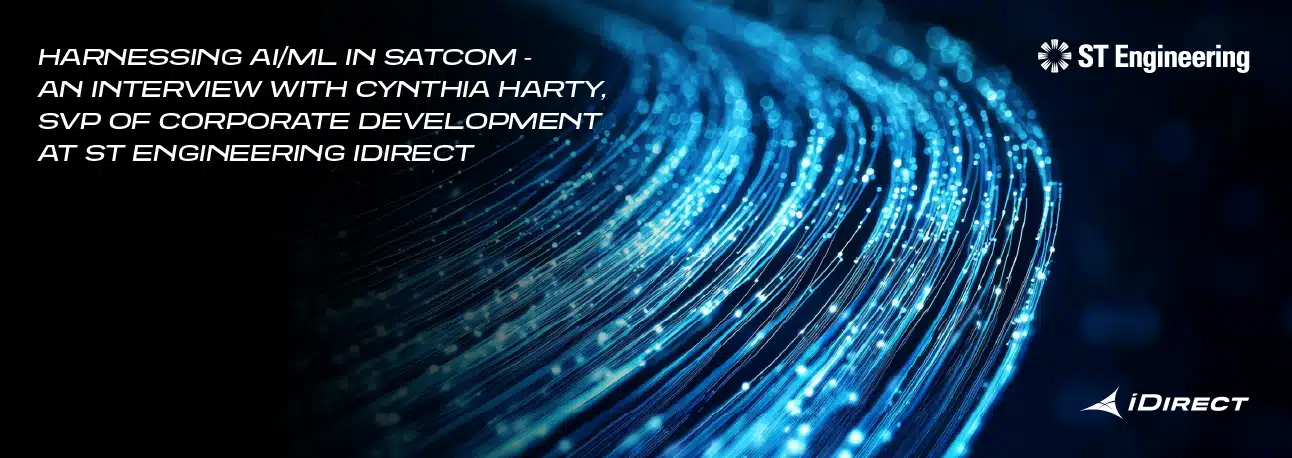Artificial Intelligence (AI) and Machine Learning (ML) are revolutionizing industries worldwide, and the satellite communications (satcom) sector is no exception. To shed light on how ST Engineering iDirect is driving innovation in this space, we spoke with Cynthia Harty, Senior Vice President of Corporate Development. Below, Cynthia shares her insights on the role of AI/ML in satcom, the company’s initiatives, and the future of smart, automated networks.

Cynthia, how is AI/ML transforming the satcom industry?
AI/ML is truly a game-changer for satcom. It allows us to optimize network performance, increase efficiency, and predict failures before they occur. By incorporating AI/ML-driven algorithms, we can adapt to changing conditions in real-time and ensure high-quality service delivery. AI/ML enables us to go beyond reactive operations; it empowers us to be proactive and predictive, paving the way for smarter networks that can self-heal and self-optimize.
Can you tell us more about ST Engineering iDirect’s AI/ML initiatives?
At ST Engineering iDirect, we are committed to harnessing the power of AI and ML to enhance our satcom solutions. To drive this forward, we are forming an Automation Advisory Council, bringing together satellite operators and service providers to collaboratively shape the development and implementation of AI-based technologies. This council plays a critical role in aligning our efforts with customer needs while keeping us at the forefront of innovation. By integrating AI/ML into our product portfolio, we are creating intelligent networks that redefine reliability and efficiency in satcom solutions.
What role does the Automation Advisory Council play in driving innovation?
The Automation Advisory Council serves as a think tank where we can share ideas, identify challenges, and create solutions with our partners and customers. By leveraging insights from outside consultants and telco experts, the council aims to develop comprehensive blueprints and best practices that tackle the complexities of satcom networks. This collaborative approach ensures that our advancements align with industry requirements while also pushing the boundaries of what’s possible.
The council is supported by data scientists, AI, and analytics experts from our parent company, ST Engineering, utilizing proprietary tools, an advanced data analytics platform, and the resources of its AI Centre of Excellence. With ST Engineering’s commitment to innovation—including investing up to 5% of revenue in R&D, with 75% focused on digital technologies—the council is well-equipped to deliver tailored, AI-driven solutions that optimize network performance. These solutions will be available to both council members and ST Engineering iDirect’s customers, advancing their satcom networks.
How do the current ST Engineering iDirect’s AI/ML proof-of-concept (PoC) demos enhance performance efficiency and improve network reliability?
- Our AI-driven Chatbot demo showcases how AI can be used to improve customer support and service by leveraging a large language model (LLM) and retrieval-augmented generation (RAG) process to synthesize information from various data sources. The chatbot can understand user queries and provide accurate responses in different languages which not only frees up our Technical Assistance Center (TAC) resources but also enhances the overall customer experience by providing immediate responses.
- Our Assisted Troubleshooting demo uses AI-based anomaly detection toolsets to detect and identify issues when there are statistical outliers. Operators can quickly pinpoint problem areas and implement effective solutions, minimizing downtime and ensuring optimal network efficiency.
- Our Noise Detection demo leverages advanced ML algorithms to enhance the detection and classification of phase noise and RF impairments. By analyzing real-time patterns and identifying anomalies within signal data, the system can accurately characterize disruptions to quickly implement corrective measures to stabilize the signal ensuring overall system performance.
- Finally, Zero-Touch Adaptive Coding and Modulation (ACM) demonstrates how real-time channel performance optimization can be achieved using (ML) algorithms to continuously monitor channel conditions and dynamically adjust modulation and coding schemes. This eliminates the need for manual configuration, enabling a truly “zero-touch” solution that maximizes data throughput autonomously.
The Automation Advisory Council members will play an active role in the phase 2 proof-of-concept planning that is currently underway. Their collaboration will help refine strategies, address challenges, and identify opportunities to ensure the proof of concepts deliver meaningful results.
What do you see as the future of AI in satcom?
The future is incredibly exciting. With AI and ML, we’re moving toward a fully autonomous network where satellite systems will dynamically make intelligent decisions. This means minimal manual intervention, higher uptime, and enhanced service quality for end-users. AI/ML will also play a significant role in supporting complex applications like IoT and connectivity for remote regions where rapid adaptability is essential. We envision AI/ML becoming the backbone of satcom networks, enabling seamless, intelligent, and sustainable connectivity.
